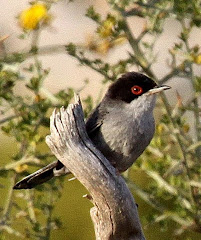
October 25, 2011:
A juvenile Pectoral Sandpiper was on flooded farmland here for the fifth successive day today. It fed almost continuously on the muddy margins of the large puddles in the field and seemed to have a favoured area of limited size.


It was nicely plumaged, its darker breast markings finishing abruptly as a sharp border in the pectoral region, hence its name. It had a partial eye-stripe running slightly behind the eye, mustard-yellow legs, and strongly contrasting wing feathers reminiscent of a Ruff.

It fed avidly with both a pecking and a sewing-machine motion (cf Dowitchers) and preened occasionally but was also very wary, posing in an upright manner to check for danger. This is a high arctic bird which nests on the tundra of the North American continent and, similar to many other birds from there this autumn, had been blown well of course eastwards during its southerly migration.



[The flooded field favoured by the Sandpiper]













.jpg)



